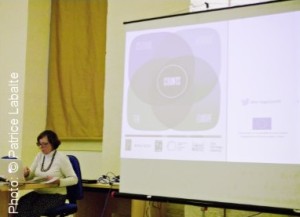On 22 October in Lecce, Italy the CHCFE project was presented during the 23rd ENCATC Annual Conference “The Ecology of Culture”. During the “Creative Heritage” Seminar, Claire Giraud-Labalte, CHCFE Steering Committee Member and Chair of the ENCATC Thematic Area “Understanding Heritage” lead this gathering that focused on the managment of an archaeology site and best practice examples of co-creation and community engagement in the preservation and valorization of Cultural Heritage.
The occasion was a perfect setting to present the project and its main findings to this audience of 26 academics, researchers and heritage professionals from Belgium, Canada, China, Finland, France, Italy, Lithuania, Netherlands, Serbia, and the United States. The project results presentation complimented seminar’s aims to: present and promote local practices relating to the conceptual framework of the Annual Conference theme on the ecology of culture; experience cross-fertilization with experts from different disciplinary backgrounds, take into account current events in the field of cultural heritage and museums; and promote the exchange of knowledge and networking for future join-projects.
Claire Giraud-Labalte also gave a presentation on “What’s new for Cultural Heritage?” For the seminar’s many international participants, she provided a brief history of European cultural heritage policy and the latest major EU developments impacting cultural heritage. This presentation also provided examples of new perspectives for cultural heritage from the Council of Europe, the Namur Declaration, and the European Cultural Heritage Year 2018.
The seminar also included two study visits, first to the archaeology Rudiae site in Salento with a guided tour by Francesco D’Andria, Professor Emeritus, University of Salento, Italy and Grazia Semeraro, Professor, University of Salento, Italy. This was followed by a visit of the Diffused Museum of Cavallino with a tour given by Grazia Semeraro, the Museum’s Director.
Seminar Material
Presentation by Claire Giraud-Labalte | Download here.
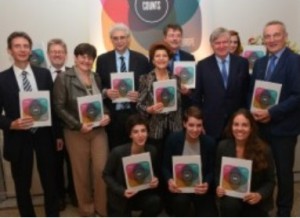
From Left to Right standing: Walter Zampieri, Brian Smith, Sneska Quaedvlieg-Mihailovic, Prof. Jacek Purchla, Former Commissioner Androulla Vassiliou, Prof. Koen Van Baelen, Denis de Kergorlay, Irene Braam, Piet Jaspaert
From Left to Right kneeling: Danae Anastopoulos-Chaimowicz, Aziliz Vandesande, Louise van Rijckevorsel
Photo: Detlef Grosse
Keeping the momentum for cultural heritage that has been so visible in Europe for the past two years with the adoption of major policy documents by all EU institutions, and most recently by the European Parliament with the adoption on 8 September of the Resolution of the European Parliament “Towards an integrated approach to cultural heritage for Europe”, members of the Cultural Heritage Counts for Europe consortium organised a special networking event to officially present the CHCFE final publication in Brussels. Led by the CHCFE project leader, Europa Nostra and its corporate partner Bertelsmann, the event was held on the evening of 22 September 2015 at the Bertelsmann’s Brussels Office.
The event was attended by former European Commissioner for Education, Culture, Multilingualism and Youth, Androulla Vassiliou, as special guest, as well as by officials of various European Commission Directorate Generals, representatives of the Permanent Representations of EU Member States and Members of the European Heritage Alliance. The directors of the two research partners, Professor Jacek Purchla of the International Cultural Centre in Krakow and Professor Koen Van Baelen of the Raymond Lemaire Centre for Conservation, briefly presented the Full Report ‘Cultural Heritage Counts for Europe’. The Report is the result of a two-year project supported by the Culture Programme of the European Union which provides compelling evidence of the impact of cultural heritage on the economy, society, culture and the environment.
In their presentation, they highlighted some key findings which are particularly relevant for EU policy circles: first, that cultural heritage represents a great potential for return in investment in fields as varied as employment and job creation, regional attractiveness, quality of life, climate change, education, lifelong learning and social cohesion; second, that cultural heritage can become a major driver of sustainable development when policies and investments related to all these fields are well coordinated; and third, that until now this full potential still remains largely untapped.
Following the presentations, former European Commissioner, Androulla Vassiliou, warmly thanked the researchers for producing such an important document, which provides relevant, factual information necessary to substantiate heritage policies across policy fields, thereby contributing to the implementation of a truly integrated approach to cultural heritage at all levels of governance.
Irene Braam, Senior Vice-President Government Relations and Head of the Bertelsmann Brussels Liaison Office, was delighted to host this event. “Bertelsmann is very proud to be the corporate partner of Europa Nostra. We also congratulate the authors of the important book “Cultural Heritage Counts for Europe” to the printing of which Bertelsmann was glad to contribute”.
The holding of this event was particularly timely, one week prior to the debate organised by the Italian and Spanish Permanent Representations on the proposal to establish 2018 as the European Year of Cultural Heritage entitled ‘A European Year of Cultural Heritage: sharing heritage, a common challenge’ (on 28 September 2015) and one month before the European Culture Forum was scheduled to be held by the European Commission (which was unfortunately cancelled due for security reasons).
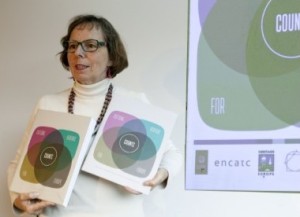
Claire Giraud-Labalte, member of the CHCFE Steering Committee on behalf of ENCATC and chair of the ENCATC Thematic Area Chair of “Understanding Heritage”
The results of the Cultural Heritage Counts for Europe project were presented to the Reflection Group “EU and Cultural Heritage” during their meeting held from 23-25 September in Luxembourg. Reflection group member, Claire Giraud-Labalte, member of the CHCFE Steering Committee, ENCATC Thematic Area Chair of “Understanding Heritage” and ENCATC Ambassador, was invited to present the project’s final publication and key findings along with Piet Jaspaert, Vice-President, Europa Nostra and member of the CHCFE Steering Committee. With an audience of representatives from European institutions, UNESCO, European heritage institutes and monuments and heritage networks, it was crucial to share the project results to ensure key players in policy and heritage have the resource to provide concrete evidence of the impact of cultural heritage on the economy, society, culture and the environment.
This meeting was also the opportunity for participants to discuss the importance to cultural heritage and international relations, as well as the international dimensions inherent to local heritage, be it historical or contemporary. The 3-day programme included expert testimony from UNESCO, the Council of Europe, the European Investment Bank, European heritage and cultural networks, and national governments. Participants were also invited to study visits to discover local heritage and meet with operators in the field.
The Reflection group “EU and cultural heritage” was established during the Belgian Presidency of the Council of the European Union in 2010. Its mission, according to the Declaration of Bruges, is to study the impact on cultural heritage of EU legislation and policies and to ensure ways so that the potential of cultural heritage is better accentuated and disseminated. The Reflection Group on “EU and Cultural Heritage” composed of the representatives of EU Members States and also of European networks active in the field of cultural heritage.
Inspiracją dla rozpoczęcia projektu badawczego Cultural Heritage Counts for Europe (Dziedzictwo kulturowe ma znaczenie dla Europy) stało się przekonanie o potencjale drzemiącym w dziedzictwie kulturowym. Rezultatem tej inicjatywy jest raport, który prezentuje wieloaspektowy i holistyczny wpływ dziedzictwa na różne sfery życia – gospodarkę, społeczeństwo, kulturę i środowisko naturalne. Na przykładzie projektów z różnych krajów europejskich twórcy raportu pokazują, w jaki sposób dziedzictwo przyczynia się do tworzenia miejsc pracy, jak przekłada się na stymulowanie działalności gospodarczej w regionie i na wzrost jego konkurencyjności, jakiego rodzaju zmianę społeczną może spowodować, w jaki sposób buduje atrakcyjność miejsca, wreszcie – jaki jest związek między dziedzictwem kulturowym a ochroną środowiska.
DOWNLOAD: DZIEDZIC TWO KULTUROWE MA ZNACZENIE DLA EUROPY – SKRÓT RAPORTU
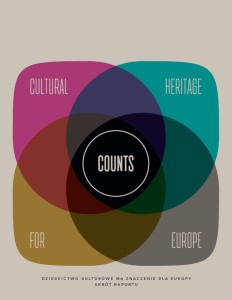 |
T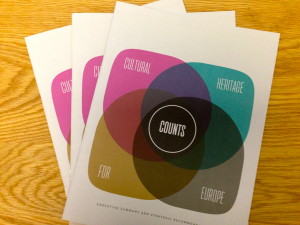 he partners of the EU-funded project ‘Cultural Heritage Counts for Europe’ (CHCFE) have published on 12 June the main findings and strategic recommendations for tapping into heritage’s full potential by providing compelling evidence of the value of cultural heritage and its impact on Europe’s economy, culture, society and the environment.
he partners of the EU-funded project ‘Cultural Heritage Counts for Europe’ (CHCFE) have published on 12 June the main findings and strategic recommendations for tapping into heritage’s full potential by providing compelling evidence of the value of cultural heritage and its impact on Europe’s economy, culture, society and the environment.
Key findings show how adopting a holistic approach is an added value when measuring the impact of cultural heritage on employment, identity, regional attractiveness, creativity and innovation, economic contribution, climate change, quality of life, education and lifelong learning, and social cohesion.
In the report’s Executive Summary and Strategic Recommendations, the CHCFE Steering Committee calls for the elaboration of specific “heritage indicators” to facilitate and improve the collection of cultural statistics which are key to support policy makers in evidence-based policy making; for the holistic impact assessment to be conducted as a requirement in all EU-funded heritage projects to better measure impact and monitor trends over a longer period of time. The Steering Committee also asks EU Institutions and its Member States at all levels of governance to integrate the care, protection and proper use of heritage in all related policies, programmes and actions and to include all stakeholders and civil society in developing strategies and policies for cultural heritage. Last but not least, it calls for the recognition of heritage’s positive contribution to regional and local sustainable development in the context of the mid-term review of the Structural Funds (in 2016-2017) and the preparation for the next generation of Structural Funds beyond 2020.
“All available evidence confirms that heritage is a strategic resource for a sustainable Europe. We need to enhance our policy action at all levels. It is time to develop a truly integrated approach to heritage, maximising the impact of heritage policies on the local economy and society. This is one of my priorities,” said Tibor Navracsics, European Commissioner for Education, Culture, Youth and Sport speaking at the launch of the CHCFE’s final report.
In addition to the key findings and strategic recommendations, the nearly 300-page report provides a snapshot in time of the currently available and accessible data within EU Members States on the wide-ranging impacts of cultural heritage in Europe. The report’s publication release builds on the momentum of policy makers recognizing the potential of Europe’s cultural heritage, most recently with the 6th Conference of Ministers responsible for Heritage organised under the Belgian Chairmanship of the Council of Europe (April 2015), but also the Horizon 2020 Expert Group on Cultural Heritage report Getting Cultural Heritage to Work (April 2015), the Conclusions on Participatory Governance of Cultural Heritage (November 2014) the Communication Towards on Integrated Approach to Cultural Heritage for Europe (July 2014), and the Conclusions on Cultural Heritage as a Strategic Resource for a Sustainable Europe (May 2014).
“The CHCfE consortium began this project to address the absence of readily accessible data on cultural heritage and of a comprehensive overview of its value and relevance on the European level which is so crucial for sound policy making. We are all pleased to see the enhanced interest which cultural heritage has generated at the EU and international level and truly hope that important body of work will contribute to strengthening the dialogue between civil society and decision makers with a view to realising the full potential of cultural heritage as a strategic resource for Europe’s future sustainable development,” states Sneška Quaedvlieg-Mihailović, Secretary General of Europa Nostra, on behalf of the CHCFE Steering Committee.
The project’s findings and final report were revealed at the CHCFE concluding conference held today at the University of Oslo and organised in conjunction with the Europa Nostra’s Annual Congress 2015. Keynote speakers included Tibor Navracsics, European Commissioner for Education, Culture, Youth and Sport, Ingvild Stub, State Secretary of the Norwegian Ministry of Foreign Affairs and Maxime Prévot, Vice-President and Minister of Wallonia’s Government. CHCFE project partners and heritage experts were also invited to present results and implications for evidence-based policy making in Europe to an audience of cultural heritage professionals, academics, researchers, and distinguished European political figures. A summary of the CHCFE concluding conference is forthcoming.
The full report and the executive summary are available for free download here.

